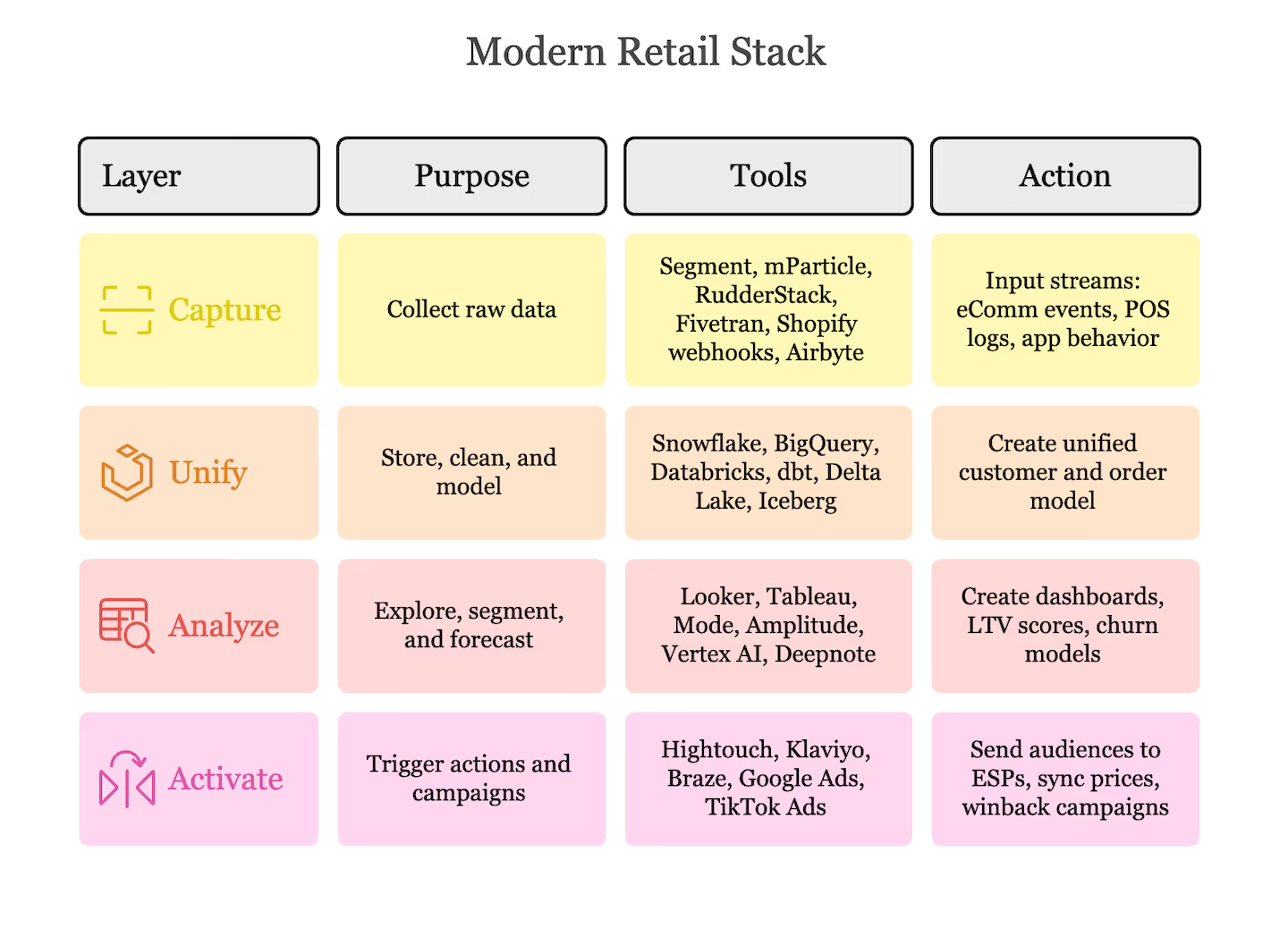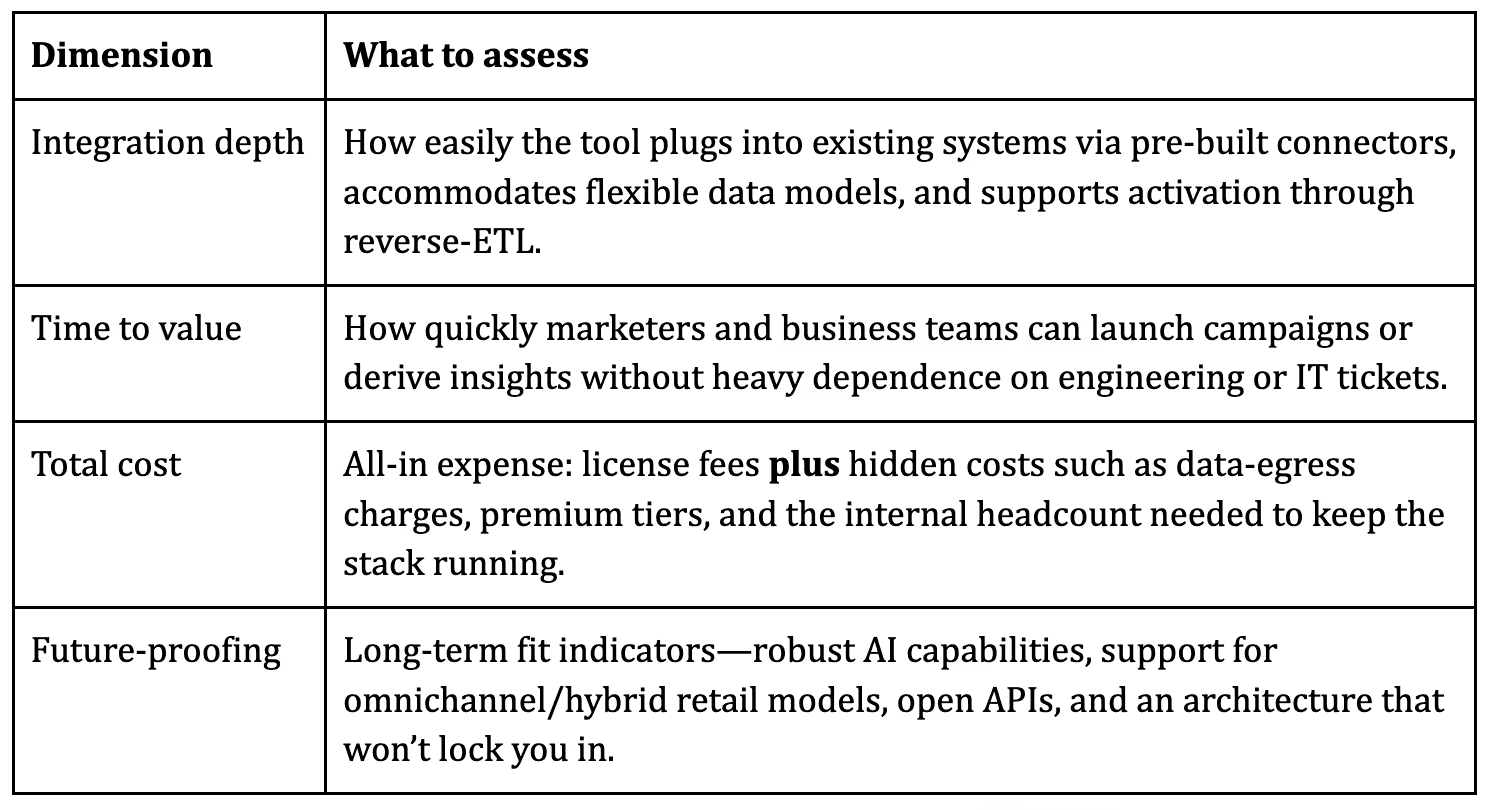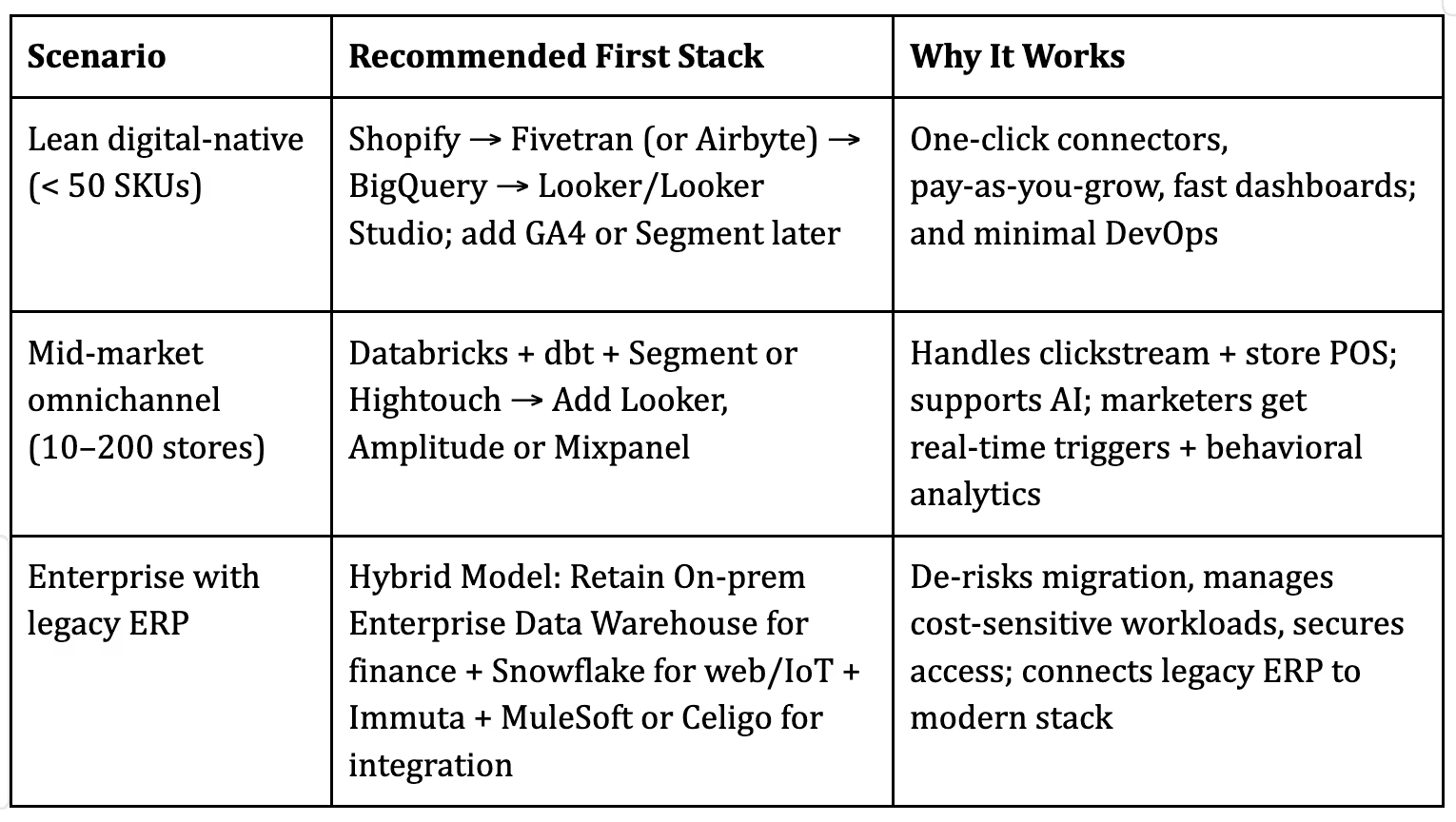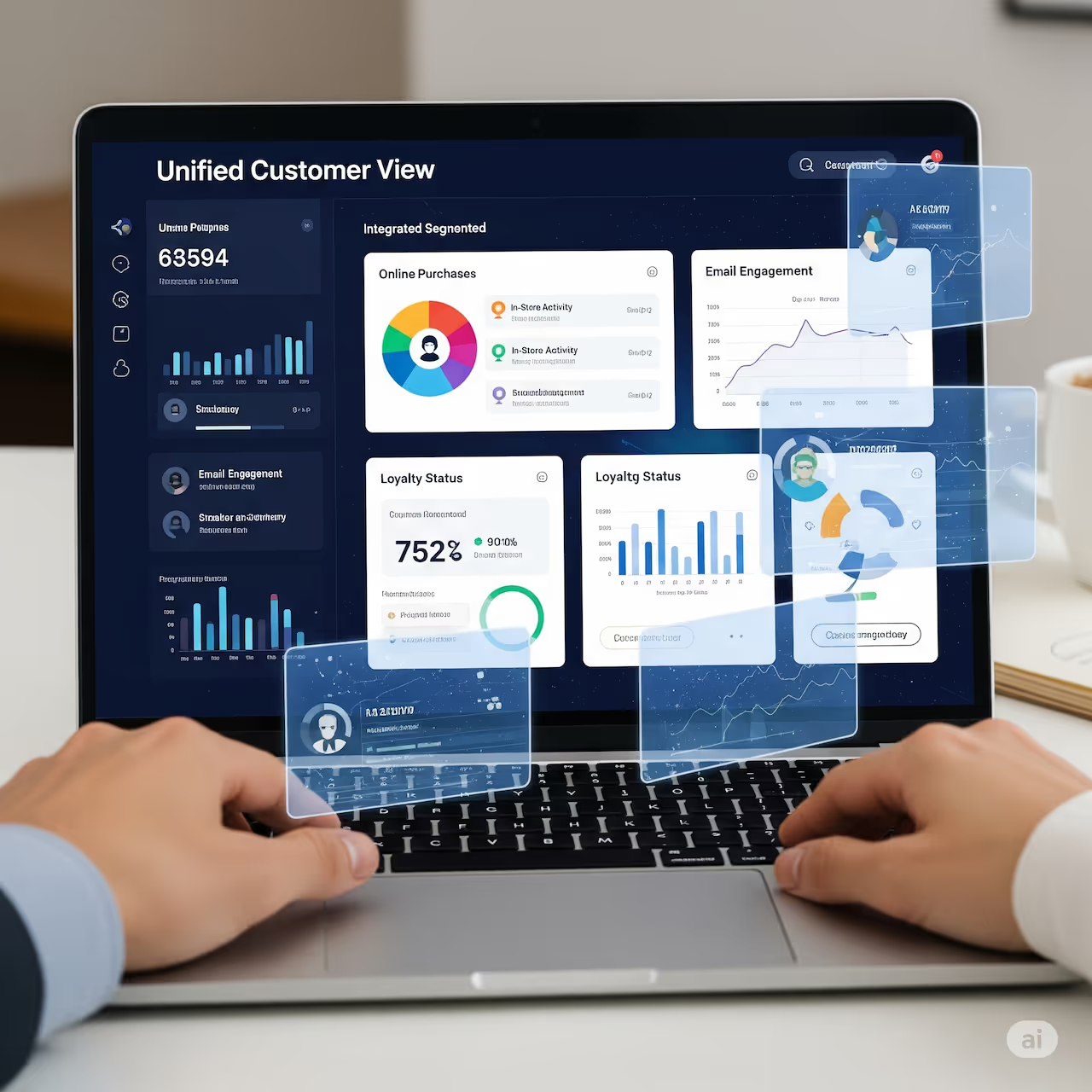Retailers today are drowning in data—POS receipts, e-commerce transactions, loyalty programs, supply chain logs, and even in-store sensors generate a goldmine of insights. Yet, many struggle to turn these insights into actionable strategies that drive profit, despite investing heavily to do just that. For context, global spend on "retail technology" will top US$131.6 billion by the end of 2025.
So what gives?
A fragmented data stack. Disconnected systems slow decisions, inflate costs, and undermine personalization—leaving growth on the table.
The stakes are real: Two-thirds of consumers abandon a brand after a poor “personalized” experience. Stockouts cost retailers nearly $1 trillion annually. And supply chain shocks can shave 6–10% off yearly revenue, not counting reputational damage.
Faced with this, retailers are asking: What does a future-proof data stack look like—and how can we build one without over-engineering? Let’s decode the answer.
The Retail Data Stack: Layers and Tools
If you’re a retailer facing whiplash demand swings and scattered data—orders in Shopify, ads in Meta, returns in a warehouse portal, inventory in ERP—it is time to swap spreadsheets for a lightweight cloud stack. What does it entail?
This is about having plug-and-play connectors that stream every source into a single warehouse, an automated transformation layer to harmonise metrics, and real-time dashboards for finance, marketing, and supply-chain teams to give them one version of the truth. Once your unified sales-and-returns dashboard goes live (which will take substantially less time than building a custom ETL), you can redirect ad spend to higher-margin SKUs, cut rush-freight costs by accurately forecasting stockouts, and ultimately turn a volatile quarter into double-digit growth.
Stack Layers:

Tip: Treat these layers like Lego bricks. Most retailers start with Capture and Unify, then add Activate once segmentation or dynamic pricing becomes a profit lever.
Trade-Offs
Retailers don’t just pick tools—they pick trade-offs. Every decision in the data stack involves balancing speed vs. control, convenience vs. customization, and cost vs. long-term flexibility. Whether you build from scratch or assemble prebuilt components, the best path depends on how quickly your teams need to act and how much complexity you're willing to own.
Build vs. Buy
Bundled suites like Salesforce Commerce Cloud or Adobe Marketing Cloud offer speed—they come pre-wired with storefront, CDP, and marketing tools. But they limit flexibility and tie you to one vendor’s pricing and roadmap.
Composable stacks let you mix best-of-breed tools: Segment captures events, Fivetran loads data into Snowflake, dbt models it, Hightouch syncs audiences, and Klaviyo executes campaigns. But this flexibility comes with integration overhead—every API and data model becomes your team’s responsibility.
Cost vs. Control
Cloud data warehouses like Snowflake scale efficiently but require engineers to manage performance and costs. No-code tools like Segment empower marketers, but advanced capabilities—AI audiences, real-time joins, privacy features—often sit behind premium tiers.
Ecosystem Alignment
Shopify brands prioritize native tools like Klaviyo and Recharge for seamless integration. ERP-heavy retailers often need middleware like MuleSoft or Celigo. These platforms act as translators, converting outdated formats into modern APIs or real-time data streams—keeping systems connected without costly overhauls.
Tip: Map each option to how quickly it enables finance or merchandising teams to act. Delayed insight is simply deferred revenue.
Evaluation Framework
To avoid costly rewrites down the line, score each vendor not just on features, but on how well they fit the business today and scale with tomorrow’s needs.
Use this 1–5 scale across dimensions:

Buyer Checklist: Pressure-Test Before You Buy
Before signing, pressure-test each tool with real-world criteria to uncover hidden costs, risks, and negotiation levers.
- Data Coverage: Can it ingest in-store as easily as online data?
- Latency: How fast from data capture (e.g., SKU change) to activation?
- Ownership: Who maintains it—vendor or internal team? Who handles API failures?
- Replatforming Risk: How hard and costly is it to switch later?
- Governance: Who owns data policies? Can we restrict access by role?
- Integrations: Does it support fast-growing channels (e.g., TikTok Shop, ONDC)? How often are connectors updated?
- Self-Service: Can marketers build segments and reports without engineering?
- Compliance & Security: GDPR/CCPA ready? SOC 2/ISO audited?
- Reliability: What’s the SLA (e.g., 99.9%)? Are outages compensated?
- Pricing: How does it scale with usage and seats? Any hidden fees?
- Data Integrity: Are we alerted to errors? Can we track and reverse them?
- Roadmap: Is the vendor stable? Can they share a 12–24 month roadmap?
Red Flag:
If a vendor can’t show retail-specific ROI or produce a live reference account in your segment, walk away. Document these answers in a side-by-side comparison grid to spot gaps, surface risks, and turn unknowns into negotiating leverage.
Final Guidance by Scenario
There’s no one-size-fits-all stack—your ideal setup depends on business model, team size, and tech maturity. Here’s how to match the stack to your stage and avoid over-engineering from day one.

The right data stack turns chaos into profit. Focus on three things: Speed (real-time decisions), Governance (stay compliant), and Modularity (stay future-ready).
Takeaway: Don’t let perfect be the enemy of good. Start small, measure ROI early, and scale with confidence. Winning retailers treat data as a core asset, not an afterthought.
Next Steps: Audit your current stack using the framework above. Where are the slowdowns, gaps, or blind spots? That’s where your roadmap begins.


.avif)

.avif)